2023 AMC 12A Problems/Problem 24
Contents
Problem
Let ![]() be the number of sequences
be the number of sequences ![]() ,
, ![]() ,
, ![]() ,
, ![]() such that
such that ![]() is a positive integer less than or equal to
is a positive integer less than or equal to ![]() , each
, each ![]() is a subset of
is a subset of ![]() , and
, and ![]() is a subset of
is a subset of ![]() for each
for each ![]() between
between ![]() and
and ![]() , inclusive. For example,
, inclusive. For example, ![]() ,
, ![]() ,
, ![]() ,
, ![]() ,
, ![]() is one such sequence, with
is one such sequence, with ![]() .What is the remainder when
.What is the remainder when ![]() is divided by
is divided by ![]() ?
?
![]()
Solution 1
Consider any sequence with ![]() terms. Every 10 number has such choices: never appear, appear the first time in the first spot, appear the first time in the second spot… and appear the first time in the
terms. Every 10 number has such choices: never appear, appear the first time in the first spot, appear the first time in the second spot… and appear the first time in the ![]() th spot, which means every number has
th spot, which means every number has ![]() choices to show up in the sequence. Consequently, for each sequence with length
choices to show up in the sequence. Consequently, for each sequence with length ![]() , there are
, there are ![]() possible ways.
possible ways.
Thus, the desired value is 
~bluesoul
Solution 2
Let ![]() be the number of sequences
be the number of sequences ![]() ,
, ![]() ,
, ![]() ,
, ![]() such that each
such that each ![]() is a subset of
is a subset of ![]() , and
, and ![]() is a subset of
is a subset of ![]() for
for ![]() ,
, ![]() ,
, ![]() . Then
. Then ![]() and
and ![]() .
.
If ![]() and
and ![]() , we need to get a recursive formula for
, we need to get a recursive formula for ![]() : If
: If ![]() , then
, then ![]() has
has ![]() possibilities, and the subsequence
possibilities, and the subsequence ![]() has
has ![]() possibilities. Hence
possibilities. Hence
![]() By applying this formula and only considering modulo
By applying this formula and only considering modulo ![]() , we get
, we get ![]() ,
, ![]() ,
, ![]() ,
, ![]() ,
, ![]() ,
, ![]() ,
, ![]() ,
, ![]() ,
, ![]() ,
, ![]() ,
, ![]() ,
, ![]() ,
, ![]() ,
, ![]() ,
, ![]() ,
, ![]() ,
, ![]() ,
, ![]() ,
, ![]() ,
, ![]() ,
, ![]() ,
, ![]() ,
, ![]() ,
, ![]() ,
, ![]() ,
, ![]() ,
, ![]() ,
, ![]() ,
, ![]() ,
, ![]() ,
, ![]() ,
, ![]() ,
, ![]() ,
, ![]() ,
, ![]() ,
, ![]() ,
, ![]() ,
, ![]() ,
, ![]() ,
, ![]() ,
, ![]() ,
, ![]() ,
, ![]() ,
, ![]() ,
, ![]() ,
, ![]() ,
, ![]() ,
, ![]() ,
, ![]() ,
, ![]() ,
, ![]() ,
, ![]() ,
, ![]() ,
, ![]() ,
, ![]() ,
, ![]() ,
, ![]() ,
, ![]() ,
, ![]() ,
, ![]() ,
, ![]() ,
, ![]() ,
, ![]() ,
, ![]() ,
, ![]() ,
, ![]() ,
, ![]() ,
, ![]() ,
, ![]() ,
, ![]() ,
, ![]() ,
, ![]() ,
, ![]() ,
, ![]() ,
, ![]() ,
, ![]() ,
, ![]() ,
, ![]() ,
, ![]() ,
, ![]() ,
, ![]() ,
, ![]() ,
, ![]() ,
, ![]() ,
, ![]() ,
, ![]() ,
, ![]() ,
, ![]() ,
, ![]() ,
, ![]() .
.
Lastly, we get ![]() .
~Quantum-Phantom
.
~Quantum-Phantom
Solution 3 (Cheese, but this time it actually works)
Seeing that all the answers are different modulus 5, and that 10 is divisible by 5, we cheese this problem.
Let ![]() be one sequence satisfying the constraints of the problem. Let
be one sequence satisfying the constraints of the problem. Let ![]() be the sequence of nonnegative integers such that
be the sequence of nonnegative integers such that ![]() has
has ![]() elements for all
elements for all ![]() , and
, and ![]() . Note that we can generate the number of valid sequences of
. Note that we can generate the number of valid sequences of ![]() by first generating all sequences of
by first generating all sequences of ![]() such that
such that ![]() for all
for all ![]() , then choosing the elements from
, then choosing the elements from ![]() that we keep in
that we keep in ![]() , given the sequence of
, given the sequence of ![]() as the restraint for the number of elements. For each sequence
as the restraint for the number of elements. For each sequence ![]() , there are
, there are 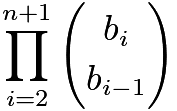 corresponding sequences for
corresponding sequences for ![]() . Now, consider two cases - either all terms in
. Now, consider two cases - either all terms in ![]() are either 0, 5, or 10, or there is at least one term in
are either 0, 5, or 10, or there is at least one term in ![]() that is neither 0, 5 nor 10. In the second case, consider the last term in
that is neither 0, 5 nor 10. In the second case, consider the last term in ![]() that is not 10 or 5, say
that is not 10 or 5, say ![]() . However, that implies
. However, that implies ![]() , and so the number of corresponding sequences of
, and so the number of corresponding sequences of ![]() is
is 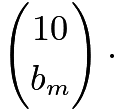 something or
something or 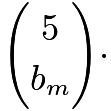 something, which is always a multiple of
something, which is always a multiple of ![]() . Therefore, we only need to consider sequences of
. Therefore, we only need to consider sequences of ![]() where each term is
where each term is ![]()
![]() or
or ![]() . If all terms in
. If all terms in ![]() are 0 or 10, then for each
are 0 or 10, then for each ![]() there are
there are ![]() sequences of
sequences of ![]() (since there are
(since there are ![]() places to turn from
places to turn from ![]() to
to ![]() ), for a total of
), for a total of ![]() (mod 5). If there exists at least one term
(mod 5). If there exists at least one term ![]() , then we use stars and bars to count the number of sequences of
, then we use stars and bars to count the number of sequences of ![]() , and each sequence of
, and each sequence of ![]() corresponds to
corresponds to ![]() sequences of
sequences of ![]() . For each
. For each ![]() , we must have at least one term of
, we must have at least one term of ![]() . After that, there are
. After that, there are ![]() stars and
stars and ![]() bars (separating
bars (separating ![]() to
to ![]() and
and ![]() to
to ![]() ), so that is
), so that is 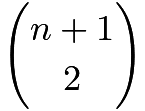 sequences of
sequences of ![]() . So the sum is
. So the sum is  (mod 5). Therefore, the answer is 0 mod 5, and it must be
(mod 5). Therefore, the answer is 0 mod 5, and it must be ![]()
Solution
We observe that in each sequence, if element ![]() , then
, then ![]() for all
for all ![]() .
Therefore, to determine a sequence with a fixed length
.
Therefore, to determine a sequence with a fixed length ![]() , we only need to determine the first set
, we only need to determine the first set ![]() that each element in
that each element in ![]() is inserted into, or an element is never inserted into any subset.
is inserted into, or an element is never inserted into any subset.
We have
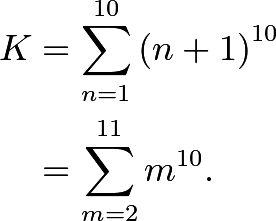
Recalling or noticing that ![]() , then,
Modulo 10, we have
, then,
Modulo 10, we have
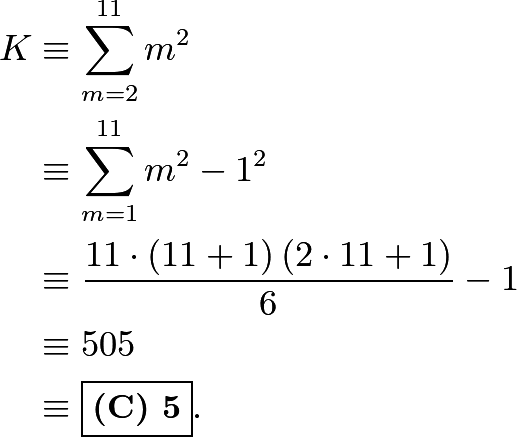
~Steven Chen (Professor Chen Education Palace, www.professorchenedu.com)
Slightly easier, observe that ![]() , so, working
, so, working ![]() , we have
, we have
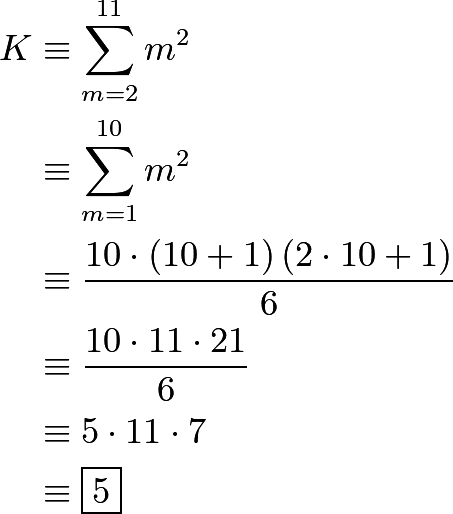
~oinava
Video Solution 1 by OmegaLearn
Video Solution
~Steven Chen (Professor Chen Education Palace, www.professorchenedu.com)
See also
| 2023 AMC 12A (Problems • Answer Key • Resources) | |
| Preceded by Problem 23 |
Followed by Problem 25 |
| 1 • 2 • 3 • 4 • 5 • 6 • 7 • 8 • 9 • 10 • 11 • 12 • 13 • 14 • 15 • 16 • 17 • 18 • 19 • 20 • 21 • 22 • 23 • 24 • 25 | |
| All AMC 12 Problems and Solutions | |
The problems on this page are copyrighted by the Mathematical Association of America's American Mathematics Competitions. 
